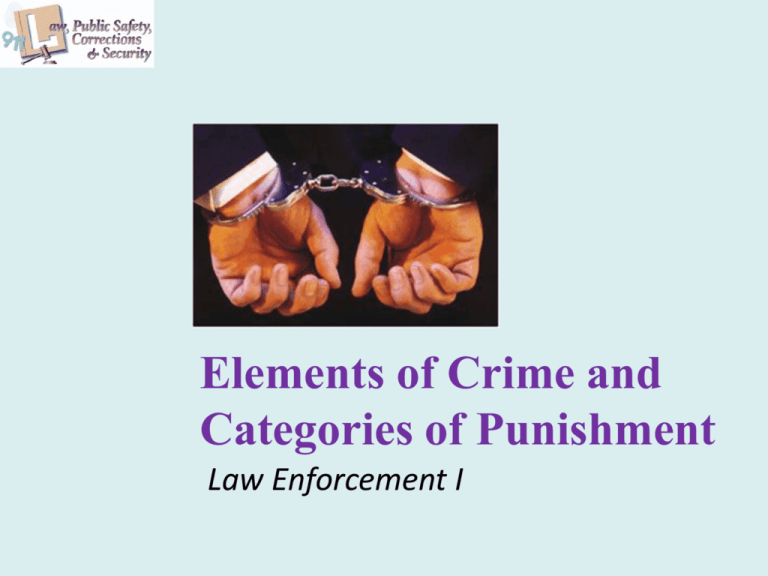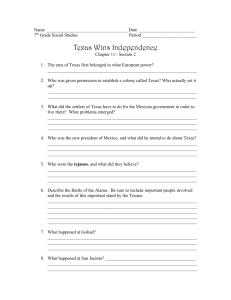
Elements of Crime and
Categories of Punishment
Law Enforcement I
Copyright and Terms of Service
Copyright © Texas Education Agency, 2011. These materials are copyrighted © and trademarked
™ as the property of the Texas Education Agency (TEA) and may not be reproduced without the
express written permission of TEA, except under the following conditions:
1) Texas public school districts, charter schools, and Education Service Centers may reproduce
and use copies of the Materials and Related Materials for the districts’ and schools’
educational use without obtaining permission from TEA.
2) Residents of the state of Texas may reproduce and use copies of the Materials and Related
Materials for individual personal use only, without obtaining written permission of TEA.
3) Any portion reproduced must be reproduced in its entirety and remain unedited, unaltered
and unchanged in any way.
4) No monetary charge can be made for the reproduced materials or any document containing
them; however, a reasonable charge to cover only the cost of reproduction and distribution
may be charged.
Private entities or persons located in Texas that are not Texas public school districts, Texas
Education Service Centers, or Texas charter schools or any entity, whether public or private,
educational or non-educational, located outside the state of Texas MUST obtain written
approval from TEA and will be required to enter into a license agreement that may involve
the payment of a licensing fee or a royalty.
Contact TEA Copyrights with any questions you may have.
Copyright © Texas Education Agency, 2011. All rights reserved.
Images and other multimedia content used with permission.
2
Origins of the Law
• Common law
• Legislatures
• Courts
Copyright © Texas Education Agency, 2011. All rights reserved.
Images and other multimedia content used with permission.
3
Age of Culpability
• Juvenile: 10–16 years of age
• Adult: 17 years of age and up
Copyright © Texas Education Agency, 2011. All rights reserved.
Images and other multimedia content used with permission.
4
Crime Conviction Requirements
• Proof beyond a reasonable doubt
• All elements of an offense have to be proven
Copyright © Texas Education Agency, 2011. All rights reserved.
Images and other multimedia content used with permission.
5
Elements of an Offense
• Forbidden conduct – this is determined by
the government
• Culpable Mental State (CMS)
• Any result
• Negation of any exception
Copyright © Texas Education Agency, 2011. All rights reserved.
Images and other multimedia content used with permission.
6
Culpable Mental States
• The attitude someone has when committing
a crime, their intentions
Copyright © Texas Education Agency, 2011. All rights reserved.
Images and other multimedia content used with permission.
7
Culpable Mental States
(continued)
• There are four types of culpable mental
states
– Intentional – conscious objective
– Knowing – aware with reasonable certainty
Copyright © Texas Education Agency, 2011. All rights reserved.
Images and other multimedia content used with permission.
8
Culpable Mental States
(continued)
• There are four types of culpable mental
states (continued)
– Reckless – aware but conscious disregard of
substantial and unjustifiable risk. Gross deviation
from what a normal person would do.
– Criminal Negligence – should have been aware of
the risk but was not
Copyright © Texas Education Agency, 2011. All rights reserved.
Images and other multimedia content used with permission.
9
Instances When Crimes Go
Without Punishment
• Exceptions – when a law does not apply to a
person the prosecutor must prove that the
person does not have a reason to do what
they are doing
• Example – the penal code says an off-duty
police officer can carry a sidearm without a
permit
Copyright © Texas Education Agency, 2011. All rights reserved.
Images and other multimedia content used with permission.
10
Instances When Crimes Go
Without Punishment (continued)
• Defense – the person has an excuse to
commit the crime
– The prosecutor does not have to negate the
existence of the defense
– The defendant must prove this exists
– If it exists, the court shall charge that this is a
reasonable doubt and the person must be
acquitted
Copyright © Texas Education Agency, 2011. All rights reserved.
Images and other multimedia content used with permission.
11
Instances When Crimes Go
Without Punishment (continued)
• Affirmative Defense – similar to a defense
– The prosecutor does not have to negate the
existence of the defense; it’s up to the defendant
– It must be proved by a preponderance of the
evidence
– Example – sexual assault/statutory rape and the
three-year exception, if the victim is at least 14
and it is consensual
Copyright © Texas Education Agency, 2011. All rights reserved.
Images and other multimedia content used with permission.
12
General Defenses Used in Trial
• Insanity
– Affirmative defense
– At the time of the conduct
– Mental disease
– Did not know the conduct was
wrong
Copyright © Texas Education Agency, 2011. All rights reserved.
Images and other multimedia content used with permission.
13
General Defenses Used in Trial
(continued)
• Mistake of Fact
– Is a defense
– The perception of the facts by the actor is
mistaken
– Has to be reasonable
Copyright © Texas Education Agency, 2011. All rights reserved.
Images and other multimedia content used with permission.
14
General Defenses Used in Trial
(continued)
• Mistake of Law – ignorance of a law is not an
excuse for breaking that law
• Intoxication – voluntary intoxication is not a
defense
Copyright © Texas Education Agency, 2011. All rights reserved.
Images and other multimedia content used with permission.
15
General Defenses Used in Trial
(continued)
• Duress
– Affirmative defense
– Not guilty if forced to commit the crime because
of the threat of death or serious bodily injury to
himself or another
– Does not apply if the person intentionally,
knowingly, or recklessly put himself in that
position
Copyright © Texas Education Agency, 2011. All rights reserved.
Images and other multimedia content used with permission.
16
General Defenses Used in Trial
(continued)
• Entrapment
– Opportunity vs. persuasion
– If the law enforcement officer induced the
person to commit the crime then this defense
applies
– Examples – bait cars and undercover agents
Copyright © Texas Education Agency, 2011. All rights reserved.
Images and other multimedia content used with permission.
17
Punishments
• Class C Misdemeanor
– Fine not to exceed $500
– Example – speeding ticket
Copyright © Texas Education Agency, 2011. All rights reserved.
Images and other multimedia content used with permission.
18
Punishments (continued)
• Class B Misdemeanor
– Fine not to exceed $2000
– Up to 180 days in jail
– Or both
– Example – DWI
Copyright © Texas Education Agency, 2011. All rights reserved.
Images and other multimedia content used with permission.
19
Punishments (continued)
• Class A Misdemeanor
– Fine not to exceed $4,000
– Up to one year in jail
– Or both
– Example – burglary of a vehicle, assault
Copyright © Texas Education Agency, 2011. All rights reserved.
Images and other multimedia content used with permission.
20
Punishments (continued)
• State Jail Felony
– Fine up to $10,000
– 180 days to two years in jail
– Or both
– Example – unauthorized use of a motor vehicle
(stealing a car)
Copyright © Texas Education Agency, 2011. All rights reserved.
Images and other multimedia content used with permission.
21
Punishments (continued)
• Third Degree Felony
– Fine up to $10,000
– 2 to 10 years in prison
– Or both
– Example – forging money
Copyright © Texas Education Agency, 2011. All rights reserved.
Images and other multimedia content used with permission.
22
Punishments (continued)
• Second Degree Felony
– Fine up to $10,000
– 2 to 20 years in prison
– Or both
– Example – aggravated assault, robbery, burglary
of a habitation, sexual assault
Copyright © Texas Education Agency, 2011. All rights reserved.
Images and other multimedia content used with permission.
23
Punishments (continued)
• First Degree Felony
– Fine up to $10,000
– 5 to 99 years in prison
– Or both
– Example – murder, aggravated robbery,
aggravated sexual assault
Copyright © Texas Education Agency, 2011. All rights reserved.
Images and other multimedia content used with permission.
24
Punishments (continued)
• Capital Felony
– Life in prison or
– Death penalty
– Example – capital murder
Copyright © Texas Education Agency, 2011. All rights reserved.
Images and other multimedia content used with permission.
25
Other Important Aspects
• Criminal Attempt
– When a person intentionally tries to commit a
crime, an act beyond mere preparation, which
tends to affect the commission of a crime
– The punishment is one level below the crime the
person is trying to commit
– Example – attempted murder
Copyright © Texas Education Agency, 2011. All rights reserved.
Images and other multimedia content used with permission.
26
Other Important Aspects
(continued)
• Criminal Conspiracy
– An agreement between two or more persons to
commit a felony and any member of the group
commits an overt act
– Overt act – any act that works towards the
commission of the offense (the act is not
necessarily a crime in and of itself).
– The punishment is one level below the most
serious crime planned
Copyright © Texas Education Agency, 2011. All rights reserved.
Images and other multimedia content used with permission.
27
Resources
• Texas Penal Code
http://www.statutes.legis.state.tx.us/
Copyright © Texas Education Agency, 2011. All rights reserved.
Images and other multimedia content used with permission.
28







